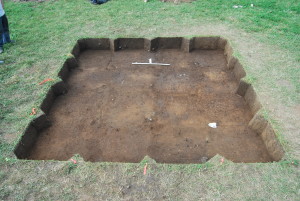 I have always viewed archaeology as sort of a doorway to the past, but I never thought that the doorway would come in the form of a four meter by four meter hole in the ground. When we arrived on the site today we were greeted by our ever so messy and intricate series of test units, separated only by even messier balks. At one point these balks served a purpose; to maintain the structure of the unit as well as to provide constant reference to the color and consistency of the soil at the initial level where we began digging as well as any changes that may have occurred whilst descending further into the ground. Now these balks pose only as rectangular pillars of dirt that stand in the way of our map of the past.
I have always viewed archaeology as sort of a doorway to the past, but I never thought that the doorway would come in the form of a four meter by four meter hole in the ground. When we arrived on the site today we were greeted by our ever so messy and intricate series of test units, separated only by even messier balks. At one point these balks served a purpose; to maintain the structure of the unit as well as to provide constant reference to the color and consistency of the soil at the initial level where we began digging as well as any changes that may have occurred whilst descending further into the ground. Now these balks pose only as rectangular pillars of dirt that stand in the way of our map of the past.
Today, we got to knock those down. As good as it felt to get through these obstacles; the real gratification came way later. After spending hours chipping away at the sides of our newly de-balked unit, with dreams of perfectly straight walls, it was time to clean the floors: an oddly exciting moment for a budding archaeologist. The floor serves as a map of the past, but with loose dirt and rocks covering a layer of finely packed sediments this map didn’t appear very clear. With blistered fingers we troweled away all of the excess materials to reveal a much clearer image. With a seasoned archaeological veteran leading our team, we concluded that what we were looking at was the remnants of a Mississippian domestic structure…or; a glorified house.
After spending the last week and a half “chasing the posts”, it felt really good to finally be able to see the bigger picture. Posts appear as darker sections of soil, usually in a relatively circular shape, that show where a post used to be. When you start to see posts coming up in a line or near the same location you can infer that they were supporting a structure. With the presence of daub, which is a substance used to help hold materials together, especially in house building, along with a large amount of charcoal concentrated mainly in one small section, we decided that this structure being supported by the posts was most likely a house. The charcoal likely represented a hearth of some sort which was common to Mississippian homes which usually had a hearth and chimney-like feature present. With all of this evidence and background knowledge to confirm our thoughts, it felt really nice to finally be able to see that we were working towards something real. A week and a half of constant digging, screening, and washing artifacts was not all for nothing, and I’m very excited to see what else we can uncover during our last week and a half!